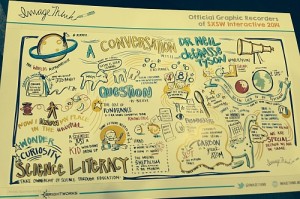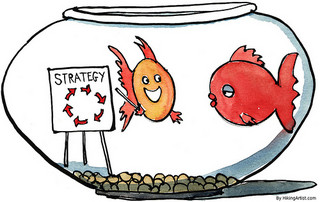My goal at SXSWi this year was to not only make it into the actual keynote presentations (which meant arriving early!), but to attend sessions that were outside of my comfort zone. I wanted to feel inspired in my everyday life and broaden my perspective both personally and professionally.
Well, I have to say that Dr. Neil deGrasse Tyson (host of FOX’s rebooted “Cosmos” show) handily — and emphatically — delivered. His Bill Cosby-like comedic chops, likeable personality, vast knowledge of science and uncanny ability to make the subject accessible to anyone — made me want to jump back into my grade school science class and learn all over again.
Tyson is, by far, one of the most engaging speakers I’ve ever come across in any conference, festival or event. And it was clear by the wild applause, hoots and hollers from the audience that they were just as captivated by him as I was.
Said Tyson: “I don’t want to hand out answers. When you explore, all those answers come for free.”
One of my favorite parts was when Tyson talked about how children perceive the world, and aren’t afraid to challenge or question the status quo. He shared a hilarious story about how he encouraged his daughter to take a skeptical view and test the myth of the Tooth Fairy. Rather than flat-out denying the childhood fantasy figure’s existence, he equipped his daughter to do experiments with her friends. What did they do? They put their teeth under their pillows without telling their parents!
My takeaway from Dr. Tyson’s keynote is to see the world through the lens of a child. Never suppress your curiosity. Test and try things out for yourself. Don’t just accept what others tell you as truth. Keeping an open mind and open heart will lead to many discoveries about yourself and the universe around you.
10 Neil deGrasse Tyson Quotes To Fuel Your Love Of Science
Courtesy of Mashable
1. “A scientist is just a kid who never grew up.”
2. “Science literacy is how much do you still wonder about the world around you. What is your state of curiosity?”
3. “You can’t just choose what is true and what isn’t.”
4. “All the nine-planet people out there, just get over it. It’s eight!”
5. “There’s so much to be impressed with in the universe. I don’t want you to be distracted by things in the universe that are not.”
6. “One reason we should go space: You know the dinosaurs would have gone there if they could have. Dinosaurs didn’t have opposable thumbs or a space program, though.”
7. “To be scientifically literate is to know when someone else is full of bologna sandwich.”
8. “The missing skepticism is the problem.”
9. “If we’re trying to go into the 21st century and be competitive, we can’t just believe we’ll be competitive.”
10. “I would encourage you to not become attached to the number of things. There’s no physics in the number of things.”
And a brilliant piece by Fredric Paul of Network World on how Dr. Tyson’s insights could apply to the world of enterprise technology and networking.
— Michele Lu Kumar, Principal of Priya PR

